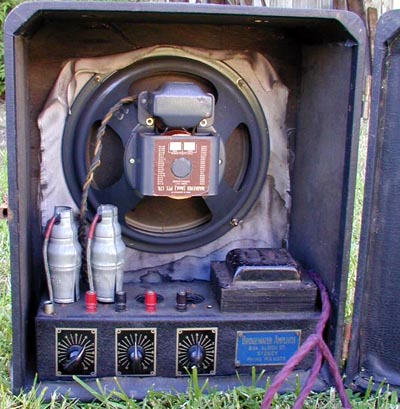About Magnetic Attraction ...in speakers...
About Magnetic Attraction ...in speakers...
Happy Valentines day ya’all! A perfect time to discuss magnetic attraction. Surly you all know that magnetic forces are what actually enable a speaker to "speak". In a nut shell, a variable electro-magnet (the voice-coil) operates in a permanent magnetic field (provided by the magnet you see on the back of the speaker). At this point I feel it is only fair to warn you that the relationship between the voice-coil and the permanent magnet is a tumultuous one. For as you know, magnets not only have the power to attract one another, they can also repel; the varying voltage applied to the voice coil (i.e. variable electro-magnet), causes the two to be constantly confused as to whether they love or hate each other! When they are smitten, the voice-coil, and the attached speaker cone lovingly cling to one another; and when they have an aversion to each other, the voice-coil and cone get as far away from the magnet as it can. It’s this delicate dance that causes a speaker to sing! Wanta dig a little deeper? Then READ ON my friendly friend!
As always, I’ll begin with the history. The earliest speakers had no such thing as a "permanent
magnet" at all because powerful permanent magnets were not yet readily
available; these are known as "field
coil" speakers and in lieu of a permanent magnet on the back, they sported
a wound electro-magnet. The rear coil on
these speakers did not provide a very high magnetic field, and required a fair
amount of current to do its thing. 
They didn’t stick around long, and were soon replaced by a speaker with a permanent magnet. These early magnets were a magnetized mixture of Aluminum, Nickel, and Cobalt; abbreviated to AlNiCo. The earliest speakers had voice-coils comprised of wire hand-wound around paper tubes; envision a toilet-paper tube and you won’t be far off.
So, we have the birth of the modern loudspeaker: A paper cone glued to a paper voice coil operating in an AlNiCo generated magnetic field. Ah, sweet vintage tone has been given life, and we all know that some of the old speakers from the 1950’s are in fact seriously sweet! Okay, if that combination works so well, why did folks ever start messing with it? Well ...
With a few watts through a kitchen radio, the classic speaker design was totally adequate; but then that darn Leo Fender had to start screwing everything up. Leo was making progressively more and more powerful guitar amps, and darn if guitar players weren’t pushing these beasts way beyond their designed operating limits, causing paper voice coils to get hot and burn out. Speakers needed to improve!
The first and easiest way to improve voice-coil power-handling performance was to simply make the voice-coils larger. To this day you will notice that, generally speaking, the larger the voice coil, the higher the power handling on a speaker will be. There is a bit of a downside; a larger voice-coil often results in a speaker that is less nimble, airy, and touch-responsive. And so it is that folks began to experiment with materials other than paper to make the voice-coils from. DuPont concocted a material they dubbed "Kapton"which it turned out made a very nice voice coil, and one that could take the heat that paper could not.
As voice-coils were getting beefier, the permanent magnetic field they operate within needed to get beefier, too. The simple solution was to just increase the size of the permanent magnet, but there was a problem with that, the AlNiCo material was starting to get expensive! Big AlNiCo magnets would mean some seriously spendy speakers. So, the engineers turned to another magnet material, what we generally refer to as a "ceramic". Ceramic, also known as Ferrite, magnets are made of a composite of iron oxide and barium or strontium carbonate. These materials are readily available and at a much lower cost than AlNiCo; this is the magnetic material that most modern speakers utilize. The down-side to Ceramic/Ferrite magnet speakers is that they don’t naturally compress at high volumes like AlNiCo models. However, this is, of course only a down-side if you want that kind of thing. You won’t find Metal players complaining that their Ceramic magnet speakers don’t compress and smooth-out enough at high volumes!
So, now it’s time for you to write your own love story. Will it be the strong and bold romance of a large and boisterous voice-coil and a powerful magnet, or will it be the more delicate dance of a diminutive voice-coil and a gentle magnet?
- VAUGHN SKOW's blog
- Log in or register to post comments

